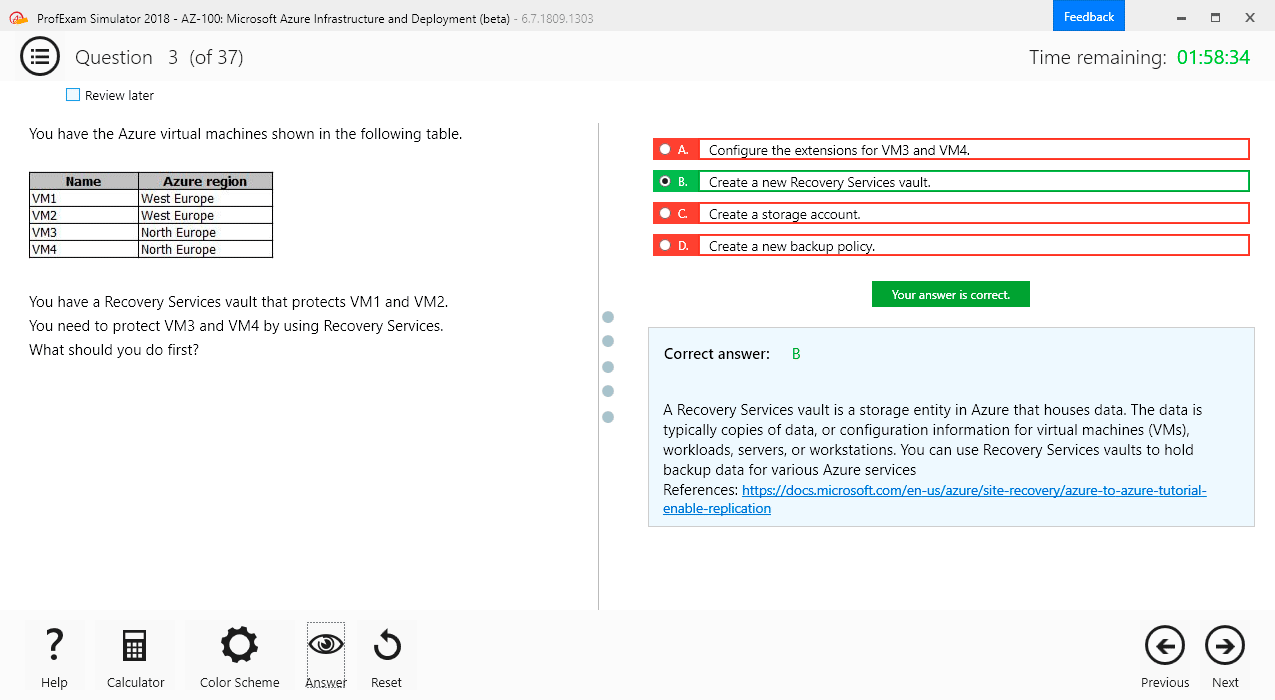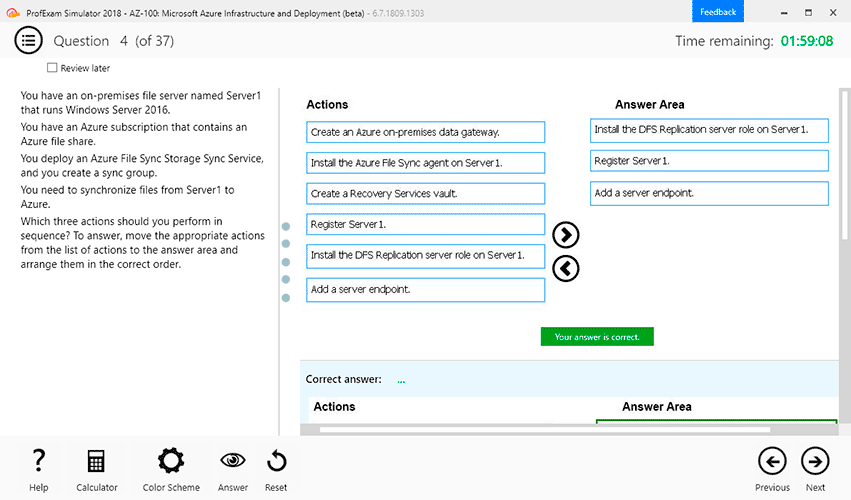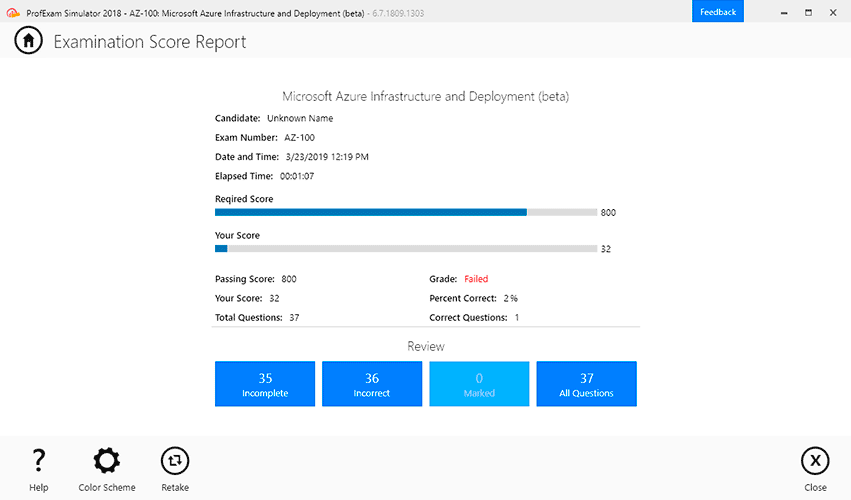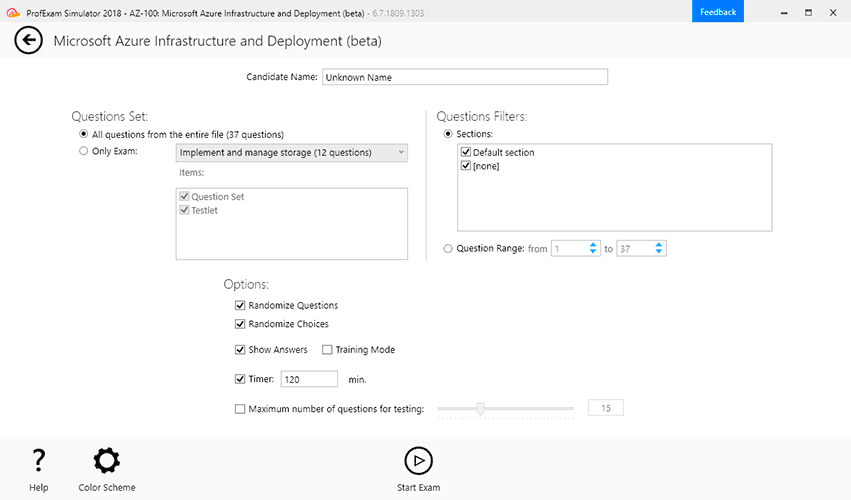File Info
| Exam | Cisco Certified Support Technician-CCST-Networking |
| Number | CCST-Networking |
| File Name | Cisco.CCST-Networking.VCEplus.2024-08-16.20q.vcex |
| Size | 695 KB |
| Posted | Aug 16, 2024 |
| Download | Cisco.CCST-Networking.VCEplus.2024-08-16.20q.vcex |
How to open VCEX & EXAM Files?
Files with VCEX & EXAM extensions can be opened by ProfExam Simulator.
Coupon: MASTEREXAM
With discount: 20%





Demo Questions
Question 1
You want to store files that will be accessible by every user on your network.
Which endpoint device do you need?
- Access point
- Server
- Hub
- Switch
Correct answer: B
Explanation:
To store files that will be accessible by every user on a network, you would need a server. A server is a computer system that provides data to other computers. It can serve data to systems on a local network (LAN) or a wide network (WAN) over the internet. In this context, a file server would be set up to store and manage files, allowing users on the network to access them from their own devices1.What is a Server?Understanding Servers and Their FunctionsA server is a computer designed to process requests and deliver data to other computers over a local network or the internet. In this case, to store files that will be accessible by every user on the network, a file server is the appropriate endpoint device. It provides a centralized location for storing and managing files, allowing users to access and share files easily.A . Access point: Provides wireless connectivity to a network.C . Hub: A basic networking device that connects multiple Ethernet devices together, making them act as a single network segment.D . Switch: A networking device that connects devices on a computer network by using packet switching to forward data to the destination device.Thus, the correct answer is B. Server.File Server Overview (Cisco)Server Roles in Networking (Cisco) To store files that will be accessible by every user on a network, you would need a server. A server is a computer system that provides data to other computers. It can serve data to systems on a local network (LAN) or a wide network (WAN) over the internet. In this context, a file server would be set up to store and manage files, allowing users on the network to access them from their own devices1.
What is a Server?
Understanding Servers and Their Functions
A server is a computer designed to process requests and deliver data to other computers over a local network or the internet. In this case, to store files that will be accessible by every user on the network, a file server is the appropriate endpoint device. It provides a centralized location for storing and managing files, allowing users to access and share files easily.
A . Access point: Provides wireless connectivity to a network.
C . Hub: A basic networking device that connects multiple Ethernet devices together, making them act as a single network segment.
D . Switch: A networking device that connects devices on a computer network by using packet switching to forward data to the destination device.
Thus, the correct answer is B. Server.
File Server Overview (Cisco)
Server Roles in Networking (Cisco)
Question 2
You want to list the IPv4 addresses associated with the host name www.companypro.net.
Complete the command by selecting the correct option from each drop-down list.
Correct answer: To work with this question, an Exam Simulator is required.
Explanation:
Using nslookup: nslookup Command Guide Using nslookup: nslookup Command Guide
Question 3
Which two pieces of information should you include when you initially create a support ticket? (Choose 2.)
- A detailed description of the fault
- Details about the computers connected to the network
- A description of the conditions when the fault occurs
- The actions taken to resolve the fault
- The description of the top-down fault-finding procedure
Correct answer: AC
Explanation:
Statement A: 'A detailed description of the fault.' This is essential for support staff to understand the nature of the problem and begin troubleshooting effectively.Statement C: 'A description of the conditions when the fault occurs.' This helps in reproducing the issue and identifying patterns that might indicate the cause of the fault.Statement B: 'Details about the computers connected to the network.' While useful, this is not as immediately critical as understanding the fault itself and the conditions under which it occurs.Statement D: 'The actions taken to resolve the fault.' This is important but typically follows the initial report.Statement E: 'The description of the top-down fault-finding procedure.' This is more of a troubleshooting methodology than information typically included in an initial support ticket.Best Practices for Submitting Support Tickets: Support Ticket Guidelines Statement A: 'A detailed description of the fault.' This is essential for support staff to understand the nature of the problem and begin troubleshooting effectively.
Statement C: 'A description of the conditions when the fault occurs.' This helps in reproducing the issue and identifying patterns that might indicate the cause of the fault.
Statement B: 'Details about the computers connected to the network.' While useful, this is not as immediately critical as understanding the fault itself and the conditions under which it occurs.
Statement D: 'The actions taken to resolve the fault.' This is important but typically follows the initial report.
Statement E: 'The description of the top-down fault-finding procedure.' This is more of a troubleshooting methodology than information typically included in an initial support ticket.
Best Practices for Submitting Support Tickets: Support Ticket Guidelines
Question 4
Move each network type from the list on the left to the correct example on the right.
Correct answer: To work with this question, an Exam Simulator is required.
Explanation:
Network Types Overview: Cisco Networking BasicsUnderstanding Different Network Types: Network Types Guide Network Types Overview: Cisco Networking Basics
Understanding Different Network Types: Network Types Guide
Question 5
You plan to use a network firewall to protect computers at a small office.
For each statement about firewalls, select True or False.
Note: You will receive partial credit for each correct selection.
Correct answer: To work with this question, an Exam Simulator is required.
Explanation:
Understanding Firewalls: Firewall CapabilitiesNetwork Security Best Practices: Network Security Guide Understanding Firewalls: Firewall Capabilities
Network Security Best Practices: Network Security Guide
Question 6
Move each protocol from the list on the left to the correct TCP/IP model layer on the right.
Note: You will receive partial credit for each correct match.
Correct answer: To work with this question, an Exam Simulator is required.
Explanation:
TCP/IP Model Overview: Cisco TCP/IP ModelUnderstanding the TCP/IP Model: TCP/IP Layers TCP/IP Model Overview: Cisco TCP/IP Model
Understanding the TCP/IP Model: TCP/IP Layers
Question 7
An app on a user's computer is having problems downloading data. The app uses the following URL to download data:
https://www.companypro.net:7100/api
You need to use Wireshark to capture packets sent to and received from that URL.
Which Wireshark filter options would you use to filter the results? Complete the command by selecting the correct option from each drop-down list.
Note: You will receive partial credit for each correct selection.
Correct answer: To work with this question, an Exam Simulator is required.
Explanation:
Wireshark Filters: Wireshark Display Filters Wireshark Filters: Wireshark Display Filters
Question 8
An engineer configured a new VLAN named VLAN2 for the Data Center team. When the team tries to ping addresses outside VLAN2 from a computer in
VLAN2, they are unable to reach them.
What should the engineer configure?
- Additional VLAN
- Default route
- Default gateway
- Static route
Correct answer: C
Explanation:
When devices within a VLAN are unable to reach addresses outside their VLAN, it typically indicates that they do not have a configured path to external networks. The engineer should configure a default gateway for VLAN2.The default gateway is the IP address of the router's interface that is connected to the VLAN, which will route traffic from the VLAN to other networks12.* Understanding and Configuring VLAN Routing and Bridging on a Router Using the IRB Feature* VLAN 2 not able to ping gateway - Cisco Community=========================* VLANs: Virtual Local Area Networks (VLANs) logically segment network traffic to improve security and performance. Devices within the same VLAN can communicate directly.* Default Gateway: For devices in VLAN2 to communicate with devices outside their VLAN, they need a default gateway configured. The default gateway is typically a router or Layer 3 switch that routes traffic between different VLANs and subnets.* Additional VLAN: Not needed in this scenario as the issue is related to routing traffic outside VLAN2, not creating another VLAN.* Default Route: While a default route on the router may be necessary, the primary issue for devices within VLAN2 is to have a configured default gateway.* Static Route: This is used on routers to manually specify routes to specific networks but does not address the need for a default gateway on the client devices.* Cisco VLAN Configuration Guide: Cisco VLAN Configuration* Understanding and Configuring VLANs: VLANs Guide When devices within a VLAN are unable to reach addresses outside their VLAN, it typically indicates that they do not have a configured path to external networks. The engineer should configure a default gateway for VLAN2.
The default gateway is the IP address of the router's interface that is connected to the VLAN, which will route traffic from the VLAN to other networks12.
* Understanding and Configuring VLAN Routing and Bridging on a Router Using the IRB Feature
* VLAN 2 not able to ping gateway - Cisco Community
=========================
* VLANs: Virtual Local Area Networks (VLANs) logically segment network traffic to improve security and performance. Devices within the same VLAN can communicate directly.
* Default Gateway: For devices in VLAN2 to communicate with devices outside their VLAN, they need a default gateway configured. The default gateway is typically a router or Layer 3 switch that routes traffic between different VLANs and subnets.
* Additional VLAN: Not needed in this scenario as the issue is related to routing traffic outside VLAN2, not creating another VLAN.
* Default Route: While a default route on the router may be necessary, the primary issue for devices within VLAN2 is to have a configured default gateway.
* Static Route: This is used on routers to manually specify routes to specific networks but does not address the need for a default gateway on the client devices.
* Cisco VLAN Configuration Guide: Cisco VLAN Configuration
* Understanding and Configuring VLANs: VLANs Guide
Question 9
A host is given the IP address 172.16.100.25 and the subnet mask 255.255.252.0.
What is the CIDR notation for this address?
- 172.16.100.25 /23
- 172.16.100.25 /20
- 172.16.100.25 /21
- 172.16.100.25 /22
Correct answer: D
Explanation:
The CIDR (Classless Inter-Domain Routing) notation for the subnet mask 255.255.252.0 is /22. This notation indicates that the first 22 bits of the IP address are used for network identification, and the remaining bits are used for host addresses within the network1.* Subnet Cheat Sheet -- 24 Subnet Mask, 30, 26, 27, 29, and other IP Address CIDR Network Reference=========================* Subnet Mask to CIDR Notation: The given subnet mask is 255.255.252.0. To convert this to CIDR notation:* Convert the subnet mask to binary: 11111111.11111111.11111100.00000000* Count the number of consecutive 1s in the binary form: There are 22 ones.* Therefore, the CIDR notation is /22.* Understanding Subnetting and CIDR: Cisco CIDR Guide The CIDR (Classless Inter-Domain Routing) notation for the subnet mask 255.255.252.0 is /22. This notation indicates that the first 22 bits of the IP address are used for network identification, and the remaining bits are used for host addresses within the network1.
* Subnet Cheat Sheet -- 24 Subnet Mask, 30, 26, 27, 29, and other IP Address CIDR Network Reference
=========================
* Subnet Mask to CIDR Notation: The given subnet mask is 255.255.252.0. To convert this to CIDR notation:
* Convert the subnet mask to binary: 11111111.11111111.11111100.00000000
* Count the number of consecutive 1s in the binary form: There are 22 ones.
* Therefore, the CIDR notation is /22.
* Understanding Subnetting and CIDR: Cisco CIDR Guide
Question 10
You need to connect a computer's network adapter to a switch using a 1000BASE-T cable.
Which connector should you use?
- Coax
- RJ-11
- OS2 LC
- RJ-45
Correct answer: D
Explanation:
* 1000BASE-T Cable: This refers to Gigabit Ethernet over twisted-pair cables (Cat 5e or higher).* Connector: RJ-45 connectors are used for Ethernet cables, including those used for 1000BASE-T.* Coax: Used for cable TV and older Ethernet standards like 10BASE2.* RJ-11: Used for telephone connections.* OS2 LC: Used for fiber optic connections.* Ethernet Standards and Cables: Ethernet Cable Guide * 1000BASE-T Cable: This refers to Gigabit Ethernet over twisted-pair cables (Cat 5e or higher).
* Connector: RJ-45 connectors are used for Ethernet cables, including those used for 1000BASE-T.
* Coax: Used for cable TV and older Ethernet standards like 10BASE2.
* RJ-11: Used for telephone connections.
* OS2 LC: Used for fiber optic connections.
* Ethernet Standards and Cables: Ethernet Cable Guide

